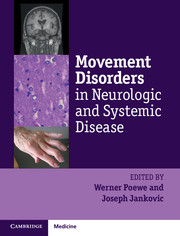Book contents
- Frontmatter
- Contents
- List of contributors
- List of videos
- List of abbreviations
- Preface
- Section I General principles
- Section II Movement disorders in systemic disease
- Chapter 4 Paraneoplastic movement disorders
- Chapter 5 Movement disorders of autoimmune origin
- Chapter 6 Movement disorders in systemic infections
- Chapter 7 Movement disorders in HIV- and AIDS-related central nervous system infections
- Chapter 8 Movement disorders in metabolic diseases in adulthood
- Chapter 9 Movement disorders in childhood metabolic diseases
- Chapter 10 Movement disorders in endocrinological diseases
- Chapter 11 Movement disorders in liver disease
- Chapter 12 Movement disorders in renal diseases
- Chapter 13 Movement disorders in hematological disease
- Section III Iatrogenic and toxic movement disorders
- Section IV Movement disorders in general neurology
- Section V Systemic complications of movement disorders
- Index
- Plate Section
- References
Chapter 10 - Movement disorders in endocrinological diseases
from Section II - Movement disorders in systemic disease
Published online by Cambridge University Press: 05 April 2014
- Frontmatter
- Contents
- List of contributors
- List of videos
- List of abbreviations
- Preface
- Section I General principles
- Section II Movement disorders in systemic disease
- Chapter 4 Paraneoplastic movement disorders
- Chapter 5 Movement disorders of autoimmune origin
- Chapter 6 Movement disorders in systemic infections
- Chapter 7 Movement disorders in HIV- and AIDS-related central nervous system infections
- Chapter 8 Movement disorders in metabolic diseases in adulthood
- Chapter 9 Movement disorders in childhood metabolic diseases
- Chapter 10 Movement disorders in endocrinological diseases
- Chapter 11 Movement disorders in liver disease
- Chapter 12 Movement disorders in renal diseases
- Chapter 13 Movement disorders in hematological disease
- Section III Iatrogenic and toxic movement disorders
- Section IV Movement disorders in general neurology
- Section V Systemic complications of movement disorders
- Index
- Plate Section
- References
Summary
Introduction
Several endocrine disorders can affect any part of the central and peripheral nervous systems. Neurological complications of endocrine disorders such as neuropathy and coma in diabetes mellitus, for instance, are well recognized; however, the occurrence of secondary movement disorders (MDs) has only recently been properly appreciated in the medical literature. MDs can develop in different settings, ranging from chronic and relatively well controlled to acute, decompensated endocrine diseases.
In this chapter, we concisely describe the phenomenology and other clinical aspects of MDs most consistently found in association with several endocrinopathies. Here, we include clinical scenarios that involve the occurrence of MDs as complications of endocrinopathies, syndromes that encompass MDs and endocrinopathies, and specific situations in which independent MDs and endocrinopathies co-occur and interfere negatively with each other (see Table 10.1).
Diabetes mellitus
Hemichorea-hemiballism in non-ketotic hyperglycemia
MD can occur in both hypo- and hyperglycemia. The most widely recognized clinical scenario is that of hemichorea-hemiballism (HCHB) during non-ketotic hyperglycemia (NKH), in situations that range from pure hyperglycemia to non-ketotic hyperosmolar state (Lin and Chang 1994). The typical presentation is that of an acute, lateralized hyperkinetic syndrome in older adults with type 2 diabetes mellitus. Occasionally, more insidious onset and more generalized movements have been described. Additional features include hypotonia, weakness, pyramidal tract signs, asterixis, seizures, and altered level of consciousness. Although MDs in these cases are self-limited, the rate and degree of improvement range from days with no need for symptomatic interventions, except for correction of blood glucose level, to a persistent state lasting for months, requiring specific treatment (Oh et al. 2002; Zétola et al. 2010).
- Type
- Chapter
- Information
- Movement Disorders in Neurologic and Systemic Disease , pp. 131 - 143Publisher: Cambridge University PressPrint publication year: 2014
References
- 1
- Cited by



